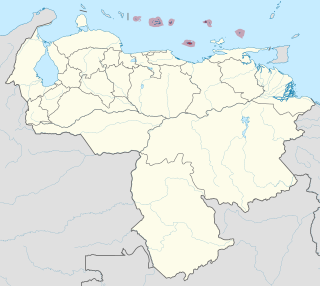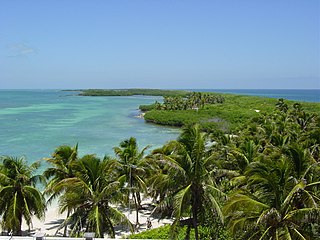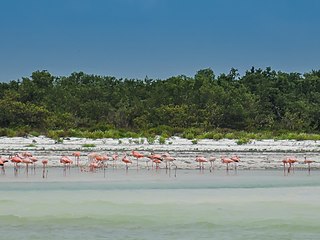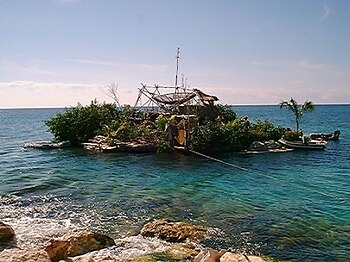
Quintana Roo, officially the Free and Sovereign State of Quintana Roo, is one of the 31 states which, with Mexico City, constitute the 32 federal entities of Mexico. It is divided into 11 municipalities, and its capital city is Chetumal.

Isla Mujeres is an island where the Gulf of Mexico and the Caribbean Sea meet, about 13 kilometres (8.1 mi) off the Yucatán Peninsula coast in the State of Quintana Roo, Mexico. It is approximately 7 kilometres (4.3 mi) long and 650 metres (2,130 ft) wide. To the east is the Caribbean Sea with a strong surf and rocky coast, and to the west the skyline of Cancún can be seen across the waters. In the 2010 census, the namesake town on the island had a population of 12,642 inhabitants. The town is the seat of Isla Mujeres Municipality.

Cozumel is an island and municipality in the Caribbean Sea off the eastern coast of Mexico's Yucatán Peninsula, opposite Playa del Carmen. It is separated from the mainland by the Cozumel Channel and is close to the Yucatán Channel. The municipality is part of the state of Quintana Roo, Mexico.

Cancún is the most populous city in the Mexican state of Quintana Roo, located in southeast Mexico on the northeast coast of the Yucatán Peninsula. It is a significant tourist destination in Mexico and the seat of the municipality of Benito Juárez. The city is situated on the Caribbean Sea and is one of Mexico's easternmost points. Cancún is located just north of Mexico's Caribbean coast resort area known as the Riviera Maya.

Dasani is a brand of bottled water created by the Coca-Cola Company, launched in 1999. It is one of many brands of Coca-Cola bottled water sold around the world. The product is filtered and bottled.

The Riviera Maya is a tourism and resort district south of Cancun, Mexico. It straddles the coastal Federal Highway 307, along the Caribbean coastline of the state of Quintana Roo, located in the eastern portion of the Yucatán Peninsula. Originally the name applied narrowly, focusing on the area of coastline between the city of Playa del Carmen and Tulum. The designation has since expanded up and down the coast, now including the towns of Puerto Morelos, situated to the north of Playa del Carmen, as well as the town of Felipe Carrillo Puerto, situated 40 km (25 mi) to the south of Tulum. This larger region is what is currently being promoted as part of the Riviera Maya tourist corridor.

An Earthship is a style of architecture developed in the late 20th century to early 21st century by architect Michael Reynolds. Earthships are designed to behave as passive solar earth shelters made of both natural and upcycled materials such as earth-packed tires. Earthships may feature a variety of amenities and aesthetics, and are designed to withstand the extreme temperatures of a desert, managing to stay close to 70 °F (21 °C) regardless of outside weather conditions. Earthship communities were originally built in the desert of northern New Mexico, near the Rio Grande, and the style has spread to small pockets of communities around the globe, in some cases in spite of legal opposition to its construction and adoption.

A floating island is a mass of floating aquatic plants, mud, and peat ranging in thickness from several centimeters to a few meters. Sometimes referred to as tussocks, floatons, or suds, floating islands are found in many parts of the world. They exist less commonly as an artificial island. Floating islands are generally found on marshlands, lakes, and similar wetland locations, and can be many hectares in size.

The Federal Dependencies of Venezuela encompass most of Venezuela's offshore islands in the Caribbean Sea and the Gulf of Venezuela, excluding those islands that form the State of Nueva Esparta and some Caribbean coastal islands that are integrated with nearby states. These islands, with a total area of 342 square kilometres, are sparsely populated – according to the preliminary results of the 2011 Census only 2,155 people live there permanently, with another hundred from Margarita Island who live there seasonally to engage in fishing. Local government is officially under the authority of Central government in Caracas, although de facto power is often held by the heads of the sparse and somewhat isolated communities that decorate the territories.

Hurricane Wilma was the most intense tropical cyclone in the Atlantic basin and the second-most intense tropical cyclone in the Western Hemisphere, both based on barometric pressure, after Hurricane Patricia in 2015. Wilma's rapid intensification led to a 24-hour pressure drop of 97 mbar (2.9 inHg), setting a new basin record. At its peak, Hurricane Wilma's eye contracted to a record minimum diameter of 2.3 mi (3.7 km). In the record-breaking 2005 Atlantic hurricane season, Wilma was the twenty-second storm, thirteenth hurricane, sixth major hurricane, fourth Category 5 hurricane, and the second costliest.

Isla Contoy is a small island in the Mexican state of Quintana Roo, approximately 30 kilometers north of Isla Mujeres. The island is only 8.5 km (5.3 mi) in length and has an area of 3.17 square kilometres (1.22 sq mi).
Juan José Sabines Guerrero is a Mexican politician, son of the former Governor of Chiapas, Juan Sabines Gutiérrez and nephew of the writer Jaime Sabines. Until, 2006 he was member of the Institutional Revolutionary Party (PRI) that carried him to be Municipal President of Tuxtla Gutiérrez, but renounced his membership to the PRI after the party denied him the chance to be a candidate for governor and asked him to finish his term as municipal president. He then became a candidate of the Coalition for the Good of All, composed by the parties PRD, PT and Convergence. He was consul of Mexico in Orlando from June 2015 to December 2018. He studied Political Sciences and Public Administration at the Universidad Iberoamericana, as well as a Diploma in Protection Within the Framework of Consular Diplomacy at Instituto Matías Romero, a Seminar in Update Finance at University of California, Berkeley and studies in Foreign Affairs at UNAM.

Wild Caribbean is a four-part BBC nature documentary series exploring the natural and cultural history of the Caribbean Islands and Sea. It was first transmitted in the UK on BBC Two in January 2007. The series was produced by the BBC Natural History Unit and narrated by actor Steve Toussaint. This series also aired in Australia on ABC1 each Sunday at 7:30pm from 15 February 2009.

The Cancún Underwater Museum is a non-profit organization based in Cancún, Mexico devoted to the art of conservation. The museum has a total of 500 sculptures, by a series of international and local sculptors, with three different galleries submerged between three and six meters deep in the ocean at the Cancún National Marine Park. The museum was thought up by Marine Park Director Jaime González Cano, with the objective of saving the nearby coral reefs by providing an alternative destination for divers. It was started in 2009 and officially opened in November 2010.
Jason deCaires Taylor is a British sculptor and creator of the world's first underwater sculpture park – the Molinere Underwater Sculpture Park – and underwater museum – Cancún Underwater Museum (MUSA). He is best known for installing site-specific underwater sculptures that develop naturally into artificial coral reefs, which local communities and marine life depend on. Taylor integrates his skills as a sculptor, marine conservationist, underwater photographer and scuba diving instructor into each of his projects. By using a fusion of Land Art traditions and subtly integrating aspects of street art, Taylor produces dynamic sculptural works that are installed on the ocean floor to encourage marine life, to promote ocean conservation and to highlight the current climate crisis.

An ecobrick is a plastic bottle densely packed with used plastic to create a reusable building block that achieves plastic sequestration.The concept behind ecobricks is to utilize and upcycle post consumer plastic, benefiting our Earth. These plastic bottles are precisely packed with clean and dry used plastic to avoid the growth of bacteria. Ecobricks can be used to produce various items, including furniture, garden walls and other structures. These plastic packed bottles are produced primarily as a means of managing consumed plastic by sequestering it and containing it safely, by terminally reducing the net surface area of the packed plastic to effectively secure the plastic from degrading into toxins and microplastics. Ecobricking is a both an individual and collaborative endeavor. The ecobricking movement promotes the personal ecobricking process as a strategy to raise awareness of the consequences of consumption and the dangers of plastic. It also promotes the collaborative process as a way to encourage communities to take collective responsibility for their used plastic and to use it to produce a useful product.

Goboat is a Danish developer and operator of solar energy-powered, picnic boats. The company opened its first terminal at Islands Brygge in Copenhagen in 2014.

Barretto Point Park is a waterfront public park on the East River located in the Hunts Point neighborhood of the Bronx. New York City. Its namesake is Francis J. Barretto, a 19th-century merchant and State Assemblyman who lived in the area.

Yum Balam Flora and Fauna Protection Area is a Mexican Flora and Fauna Protection Area located in the state of Quintana Roo in southeastern Mexico. Established in 1994, the nature reserve was the first protected area in Mexico to be created at the request of local communities. The reserve includes wetlands along the north shore of the Yucatán Peninsula and adjacent Isla Holbox and has been designated as a protected Ramsar site since 2004.

Hurricane Wilma significantly affected the Yucatán Peninsula, bringing destruction to the area. Hurricane Wilma developed on 15 October in the Caribbean. Four days later, it intensified into the strongest Atlantic hurricane on record as determined by barometric pressure. Wilma weakened as it moved slowly northwestward, eventually making landfall late on 21 October on the island of Cozumel. At the time, it was a Category 4 hurricane on the Saffir–Simpson scale. Early the next day, the hurricane made another landfall on the Mexican mainland near Puerto Morelos. Wilma exited the Yucatán Peninsula into the Gulf of Mexico on 23 October, and a day later it struck Florida.


















